

About Electromyography (EMG) and Nerve Conduction Velocities (NCV)
EMG instructions – https://neurocenter.com/wp-content/uploads/2022/05/EMG-NCS-Instructions.pdf
EMG and NCV are used to:
- Diagnose problems with the nerves and muscles in your neck, back, arms or legs
- Analyze the cause of muscle weakness, spasms, numbness, tingling, or pain of the limbs or face
These techniques are helpful in the evaluation of disorders of nerves, muscles, neuromuscular junction, and spinal cord, including pinched nerves in the arm or leg, herniated disks in the neck in the neck or back, and inflammation of the muscles.
EMG is performed with a fine disposable sterile needle electrode inserted into a muscle. Electrical activity is studied during insertion, while the muscle is at rest, and during muscle contraction.
NCV tests evaluate the function of peripheral nerves in the limbs by recording the speed with which an electrical impulse travels through it. The speed of conduction is slowed in a variety of diseases of the nervous system. It is often used to evaluate localized of diffuse numbness, weakness, or pain.
How to Prepare for an EMG/NCV
- Eat your normal meals and take your normal medications
- Bathe or shower on the day of the exam, scrubbing well to remove body oils
- Do not use bath oils, lotions, or creams.
- You should inform the physician if you are taking any blood thinners (anticoagulants), if you bruise easily, are very susceptible to infections, have a history of hepatitis or AIDS, or have a pacemaker.